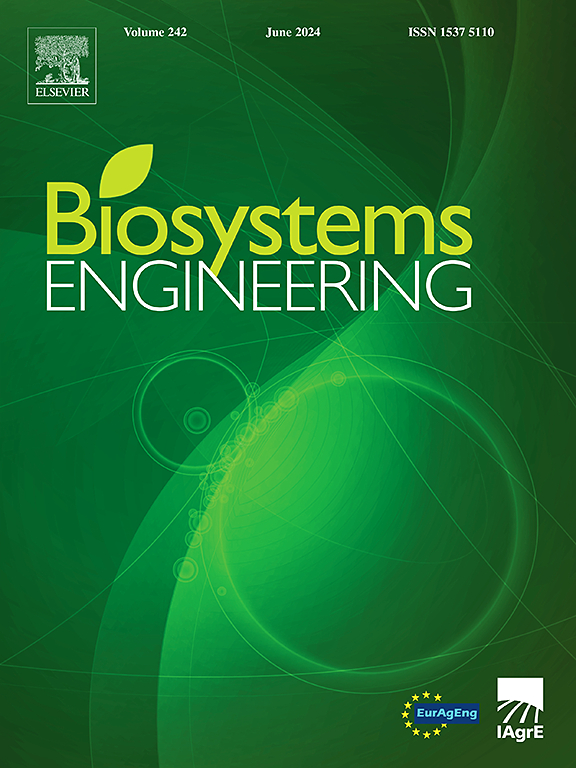Simulation and experimental study on the seed filling performance of a split cotton seeder
IF 5.3
1区 农林科学
Q1 AGRICULTURAL ENGINEERING
引用次数: 0
Abstract
To enhance the seed-filling performance of the split-type cotton seed displacer, a force analysis of the cotton seed filling process and a coupling simulation analysis were conducted. Firstly, these analyses identified three key factors influencing the seed-filling performance: vibration frequency, negative air suction pressure, and seed content in the seed box. Secondly, single-factor simulation tests were carried out on the above three influencing factors, and the influence law of each single factor on the filling performance was obtained. Ultimately, by leveraging three evaluation indices, i.e. the qualification rate, the missed-seeding rate, and the re-seeding rate, a three-factor, five-level quadratic rotational orthogonal combination test was executed. This initiative was launched to formulate the mathematical models corresponding to each influencing factor, to analyse the underlying influence mechanisms of factor interactions on the qualification rate and missed-seeding rate, and to conduct parameter optimisation coupled with experimental verification. At the optimal simulated parameter combination of a vibration frequency of 81.69 Hz, air suction negative pressure of 2.24 kPa, and the seed content of the seed box of 51.19 %, the qualification rate was 92.4 %, the missed seeding rate was 3.4 %, and the reseeding rate was 4.2 %. This was verified by a bench test that gave a qualification rate of 92.3 %, the missed seeding rate was 3.6 %, and the reseeding rate was 4.1 %. The optimisation results were validated by the results of the bench test, which meets the agronomic requirements of cotton sowing.
劈裂式棉花播种机灌种性能的模拟与试验研究
为提高劈裂式棉籽机的充种性能,对棉籽充种过程进行了受力分析和耦合仿真分析。首先,分析确定了影响种子灌浆性能的三个关键因素:振动频率、负压和种子箱内种子含量;其次,对上述三种影响因素进行单因素模拟试验,得出了各单因素对充填性能的影响规律;最终,利用合格率、漏播率、复播率三个评价指标,进行三因素五水平二次旋转正交组合试验。本项目旨在建立各影响因素对应的数学模型,分析各因素相互作用对播种合格率和未播种率的潜在影响机制,并进行参数优化并进行实验验证。在振动频率为81.69 Hz、空气吸力负压为2.24 kPa、种箱含种率为51.19%的最优模拟参数组合下,播种合格率为92.4%,漏播率为3.4%,补播率为4.2%。经台架试验验证,合格率为92.3%,漏播率为3.6%,补播率为4.1%。通过台架试验验证了优化结果,满足棉花播种的农艺要求。
本文章由计算机程序翻译,如有差异,请以英文原文为准。
求助全文
约1分钟内获得全文
求助全文
来源期刊

Biosystems Engineering
农林科学-农业工程
CiteScore
10.60
自引率
7.80%
发文量
239
审稿时长
53 days
期刊介绍:
Biosystems Engineering publishes research in engineering and the physical sciences that represent advances in understanding or modelling of the performance of biological systems for sustainable developments in land use and the environment, agriculture and amenity, bioproduction processes and the food chain. The subject matter of the journal reflects the wide range and interdisciplinary nature of research in engineering for biological systems.
 求助内容:
求助内容: 应助结果提醒方式:
应助结果提醒方式:


